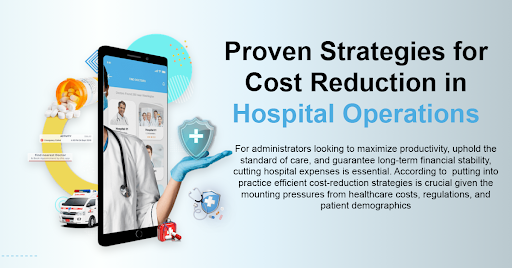
For administrators looking to maximize productivity, uphold the standard of care, and guarantee long-term financial stability, cutting hospital expenses is essential. According to Dr. Heather Bergdahl, putting into practice efficient cost-reduction strategies is crucial given the mounting pressures from healthcare costs, regulations, and patient demographics. Using efficiency, technology, resource management, and process optimization as our focal points, let us look at tried-and-true strategies for reducing hospital operating costs.
Fundamentals of Lean Management
To improve workflows, get rid of inefficiencies, and save on operating expenses, hospitals can implement lean methodologies. This includes laying out the procedures as they currently stand, locating waste, and putting continuous improvement plans into action. Dr. Heather Bergdahl asserts that hospitals can lower costs while increasing productivity, decreasing wait times, and improving patient satisfaction by promoting a lean thinking culture.
Automation and High-Tech Technology
Operating costs can be greatly decreased by making investments in automation and cutting-edge technology. Through the reduction of paperwork, the mitigation of errors, and the improvement of patient management, electronic health records, automated billing systems, and telemedicine platforms improve efficiency. Automation of administrative tasks can free up staff to concentrate on more critical tasks, thanks to technologies like robotic process automation. Optimizing resource allocation and cutting wasteful spending are two benefits of implementing predictive analytics.
Optimizing Supply Chain Management
The cost of equipment, medications, and medical supplies can all be decreased with the help of an efficient supply chain. By obtaining better deals from suppliers, buying in bulk, and implementing just-in-time inventory systems, hospitals can reduce expenses. Cutting waste, avoiding overstocking, and monitoring usage trends are all made possible by the use of inventory management software.
Improving Energy Efficiency
Hospitals can save a significant amount of money by improving their energy efficiency. Energy-saving upgrades to HVAC and lighting systems, the use of smart building technologies, and the implementation of energy-saving initiatives are some strategies. It is easier to pinpoint problem areas and monitor advancement when routine energy audits are carried out.
Cutting Shorter Stays and Readmissions
Reduce the chance of readmissions by putting in place thorough discharge planning, follow-up treatment, and patient education initiatives. Hospitals can identify patients who are at high risk and offer tailored interventions by utilizing data analytics. By optimizing bed management and streamlining clinical pathways, which reduce hospital stays and associated costs, efficient patient flow is ensured.
Employee Use and Enhanced Productivity
For cost reduction, it is essential to maximize staff productivity and usage. Hospitals can guarantee proper staffing levels and minimize overtime by putting workforce management systems in place. Employee proficiency and productivity are increased through ongoing training and development opportunities. Enhancing care delivery while reducing labor costs is possible by utilizing the skills of physician assistants and nurse practitioners.
Application of Value-Based Care Models
By bringing financial incentives into line with patient outcomes, value-based care models encourage the delivery of affordable healthcare. Hospitals can reduce duplication of services, enhance care coordination, and save money by taking part in bundled payment programs and accountable care organizations.
Frequent evaluations of finances
Finding inefficient areas and potential areas for cost reduction is made easier with regular audits of financial records. By carrying out comprehensive financial reviews, hospitals are able to allocate funds more efficiently and implement corrective actions. Transparent financial practices also help to improve accountability and facilitate strategic decision making.
Simplifying Bureaucratic Procedures
Improved operational effectiveness and decreased overhead costs are two benefits of automating administrative procedures. These duties include, for instance, processing claims, billing, and registering patients. By deploying integrated software solutions, which also ensure seamless departmental communication and simplify documentation requirements, staff time can be devoted to more valuable tasks.
Encouragement of a Cost-Aware Culture
When workers are encouraged to identify ways to reduce expenses and are involved in decision-making processes, they feel more responsible and have a sense of ownership. This culture is reinforced through training and information sharing about the importance of cost management. When cost-cutting initiatives are recognized and rewarded, staff members are even more motivated to contribute to financial efficiency.
Conclusion
In conclusion, the task of cutting costs in hospital operations is complex and calls for creative problem-solving, strategic planning, and a dedication to ongoing improvement. Dr. Heather Bergdahl concluded that hospitals can guarantee that patients receive high-quality care while efficiently managing operating costs by cultivating a culture of cost awareness and involving staff in cost reduction efforts.